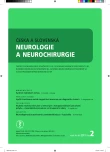Treatment of Peroneal Nerve Injury by Operation
Authors:
R. Kaiser; L. Houšťava; L. Mencl; R. Brzezný; P. Haninec
Authors place of work:
Neurochirurgická klinika 3. LF UK a FN Královské Vinohrady, Praha
Published in the journal:
Cesk Slov Neurol N 2011; 74/107(2): 187-190
Category:
Krátké sdělení
Summary
The peroneal nerve is the most frequently injured nerve of the lower extremities, most often as traction injury caused by knee distortion or iatrogenic injury. We analyze retrospectively a group of 16 of our patients. Eight of them underwent external neurolysis with functional recovery in 62%. Outcome appears to depend on the time interval between injury and operation. Another eight nerves were reconstructed with a graft from the sural nerve with a good outcome in 50% of cases. In these cases, both the timing of operation and the length of the graft used proved important – the best effect was achieved if graft length was kept below 6 cm, which corresponds with other studies. Recovery of motor function was considered satisfactory when muscle power exceeded level M3 in the standard muscle test.
Key words:
peroneal nerve injury – nerve graft repair – neurolysis
Zdroje
1. Zvěřina E, Stejskal L. Poranění periferních nervů. Praha: Avicenum 1979.
2. Kline D, Hudson AR. Nerve Injuries. Philadelphia: WB Saunders 1995.
3. Prasad AR, Steck JK, Dellon AL. Zone of traction injury of the common peroneal nerve. Ann Plast Surg 2007; 59(3): 302–306.
4. Sunderland S, Bradley KC. Stress-strain phenomena in human peripheral nerve trunks. Brain 1961; 84(1): 102–119.
5. Denny-Brown D, Brenner C. Paralysis of nerve induced by direct pressure and by tourniquet. Arch Neurol Psychiatr 1944; 51 : 1–26.
6. Nobel W. Peroneal palsy due to hematoma in the common peroneal nerve sheath after distal torsional fractures and inversion ankle sprains. J Bone Point Surg Am 1966; 48(8): 1484–1495.
7. Visser LH. High-resolution sonography of the common peroneal nerve: detection of intraneural ganglia. Neurology 2006; 67(8): 1473–1475.
8. Kim DH, Kline DG. Management and results of peroneal nerve lesions. Neurosurgery 1996; 39(2): 312–319.
9. Kim DH, Murovic JA, Tiel RL, Kline DG. Management and outcomes in 318 operative common peroneal nerve lesions at the Louisiana State University Health Sciences Center. Neurosurgery 2004; 54(6): 1421–1428.
10. Seidel JA, Koenig R, Antoniadis G, Richter HP, Kretschmer T. Surgical treatment of traumatic peroneal nerve lesions. Neurosurgery 2008; 62(3): 664–673.
11. Matejcik V, Benetin J, Hulin I jr. Our experience with surgical treatment of ischial nerve injurie. Bratisl Lek Listy 2001; 102(10): 462–465.
12. Wood MB. Peroneal nerve repair. Surgical results. Clin Orthop Relat Res 1991; 267 : 206–210.
13. Garozzo D, Ferraresi S, Buffatti P. Surgical treatment of common peroneal nerve injuries: indications and results. A series of 62 cases. J Neurosurg Sci 2004; 48(3): 105–112.
14. Nath RK, Lyons AB, Paizi M. Successful management of foot drop by nerve transfers to the deep peroneal nerve. J Reconstr Microsurg 2008; 24(6): 419–427.
15. Pilný J, Čižmář I, Ehler E, Drač P. Transpozice šlachy m. tibialis posterior – efektivní řešení parézy peroneálních svalů. Cesk Slov Neurol N 2009; 72/105(3): 279–283.
Štítky
Dětská neurologie Neurochirurgie NeurologieČlánek vyšel v časopise
Česká a slovenská neurologie a neurochirurgie

2011 Číslo 2
Nejčtenější v tomto čísle
- Syndrom neklidných nohou
- Operační léčba poranění peroneálního nervu
- Náhle vzniklá dušnost jako příznak vedoucí k diagnóze amyotrofické laterální sklerózy – kazuistika
- Invazivní mykotické sinusitidy
